|
April 1946 Radio-Craft
 [Table of Contents] [Table of Contents]
Wax nostalgic about and learn from the history of early electronics.
See articles from Radio-Craft,
published 1929 - 1953. All copyrights are hereby acknowledged.
|
As with so many things we take
for granted today, the U.S. Army Signal Corps' nationwide announcement on January
25th, 1946, that the first earth-to-moon-to-earth (EME, aka
moonbounce) contact had been made by radar was a big deal.
Hams make EMEs on a regular basis, although it still is not a simple accomplishment
and takes some special equipment. The term "selsyn" used in the article is a portmanteau
of "self-synchronous," and refers to a device for precisely positioning something
like an antenna. Magazine editor Hugo Gernsback included some kudos from contemporary
notables like Audion inventor Lee De Forest and Radio Corporation of America (RCA)
president David Sarnoff for having predicted the method and results in a 1927 article
entitled "Can We Radio the Planets? See "Moon-Radio Predicted in 1927" at the bottom
of the page.
Radio to the Moon
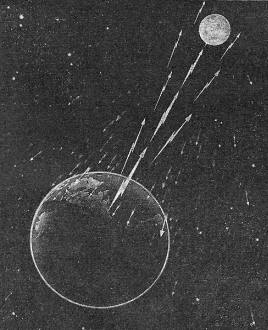
Radar signals leaving Belmar to the moon, and echoes reflected
in scattered fashion to the earth and into the space surrounding it.
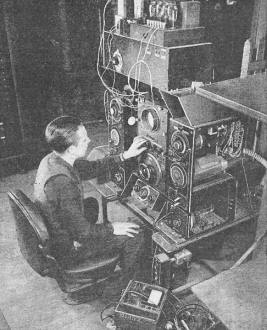
Selsyn devices for keeping the antenna array firing on the moon.
The very heavy oversize array required unusual apparatus to turn it.
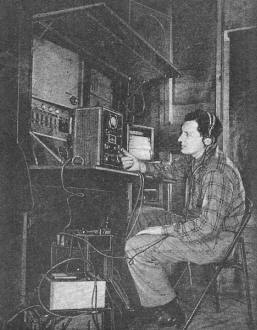
Part of the supersensitive receiver and test equipment used for
the measurements. Signal Corps Photo
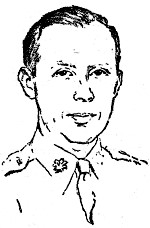
Lt. Col. John DeWitt was born 40 years ago in Nashville, Tennessee. He has been
active in radio for 20 years, during much of which time he was one of the South's
leading amateurs, W4ERI. On the professional side, he wag chief engineer of Radio
WSM and its sister FM station W47NV, at Nashville, from 1922 to 1943. Later he was
with Bell Telephone Laboratories, engaged in telephone research.
Commissioned as Major in June; 1943, he served with the Electronics Branch .
of the Engineering and Technical Service of the Office of the Chief Signal Officer,
and later as director of the Camp Evans Signal Laboratory. In this work he was responsible
for direction of a large number of projects on important weapons for the ETO, perfecting
among other devices several types of equipment for locating and pin-pointing enemy
mortar fire. Favorite hobbies, as of 1943, were amateur astronomy and amateur radio.
Is also an inveterate hunter and hiking enthusiast.
Lt. Col. John De Witt, the first send signals across cosmic space, tells how
he did it. The cover shows the Colonel and a part of his radar apparatus.
The Signal Corps' nationwide announcement on January 25th that the first earth-to-moon
contact had been made by radar was not the result of a few weeks experiment, but
of long-term thinking that began as early as 1940. We reasoned that there might
well be no theoretical limit to the distance our ionosphere-piercing signals might
travel, and therefore no theoretical straight line limit to the protecting umbrella
of our military radar.
Our contact with the German Luftwaffe proved this. The higher the enemy raiders
approached, the better our radar worked. From the start, in fact, the operation
of radar. outpaced the ceiling of high-altitude planes, and far exceeded the vertical
travel of man's most powerful anti-aircraft shell.
This led us to rightly reason that we had an instrument which, being used for
the very vital mission of saving lives, man to tells was nonetheless realizing a
small fraction of its potential use.
If, overnight, the enemy had evolved a very high-flying plane, even our war-time
radar could have coped with it. Chances are it will be a long time before such a
plane will be produced, indicating that radar science is so far ahead of man's propellant
knowledge that no tests on' a par with its space-piercing ability are as yet available
on earth.
This thinking led us to the next logical target 238,000 miles away - the moon.
When we broke through to this satellite at two minutes before noon on January 10,
just as it cleared the horizon, we knew we had broken through the encircling ring
of the ionosphere. A priceless bit of information-that our signals could and were
piercing the void of ether between planets-was ours! (Continued on page 501)
Knowledge that we have this power to carry through the vacuum of outer stellar
space, proved by the echo from the satellite, means even more: that we can extend
man's control and influence into voids far removed from the earth.
What I mean by control is our every-day ability to push a button and re-route
a railroad train, or press a switch and light up a room, or dial a phone and talk
across a city.
On January 10th we learned we could push a button and make things happen in outer
space, for the calculated intensity of our signal delivered on the face of the moon,
sufficient to produce an echo on earth, is far more than needed to control a device
on the face of the moon, or anywhere in space between s and it.
It's no trick at all, for instance, to control a pilotless plane or operate a
driverless vehicle on the face of the earth by a simple remote control box. We did-that
five years before the war. But after January 10th we know that we can do it as far
away as the moon, or on the face of the moon if you like.
That really is the significance of our discovery. Not that with a dozen years
of delicate watch-like radar improvement we could map the moon, now fairly well
done with a good telescope. By the time we map the moon by earth radar, these radars
will be controlling an inter satellite service which, being on the spot, will be
able to do map making as a subsidiary or incidental assignment. In short, radar
has presented a means of control and communication well in advance of man's ability
to project himself in space. And it may well be the means which will lead to it.
To provide any sort of concrete proof that our radar was reaching the moon it
was obvious, lacking a lunar receiving station to report on our signals, that we
had to send a signal to the satellite so strong that we could check our own echo.
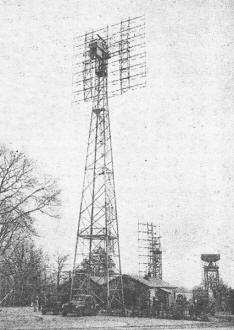
Antennas at Evans Signal Laboratory, Belmar, New Jersey, where
the' moon contact was made. The big one in foreground sent the signals. Acme Photo
For this we used 64 dipole antennas in phase with a reflecting surface behind
- standard radar equipment merely doubled in size, power gain approximately 200.
Our transmitter operated on 112 megacycles, peak power around 4 kw, pulse duration ½
second, repetition rate 1 pulse each 5 seconds. The transmitter was crystal controlled,
using a 500 kc bar and employing frequency multiplier stages to reach a final amplifier
output of 112 megacycles. This final power amplifier used during early tests and
prior to the announcement of the contact, used two Eimac 1000-T tubes in a conventional
v.h.f. push-pull circuit.
Far more complex was the receiver which, built with a sensitivity of 0.01 microvolts,
is about 200 times as sensitive as the most progressive type communication receiver
available to the public today. This sensitivity was absolutely necessary, our closest
calculations showed us.
Astronomically, we knew that the surface of the moon was lava which, measured
on earth, has a dielectric constant of about 6. This meant that about 16 percent
or 3 watts of our energy striking the moon would be reradiated in all directions.
Our receiver, therefore, would have to be sensitive enough to pick up signals not
stronger than would be sent from a 3-watt walkie-talkie operating on the moon.
Basically, the receiver is a 4-mixer superheterodyne with all but one of the
mixer injection frequencies controlled by the transmitter crystal to provide locking
with the transmitter frequency. The fourth mixer is provided with an adjustable
frequency crystal to establish the final i.f. for the exact for frequency to be
received. The receiver's input frequency differs from the transmitter frequency
by an amount depending upon the Doppler Effect due to the moon's velocity. When
the moon. rises we are speeding toward it 834 to 626 miles per hour, Doppler Effect
increasing the frequency o-f the echo signal between 279 and 209 cycles from the
transmitted signal. At moon-set, we recede from the satellite at from 891 to 578
m.p.h. which decreases the echo signal frequency anywhere from 287 to 188 cycles.
This exact frequency measurement of the Doppler Effect on our radar signals, incidentally,
provided a proof positive of contact with the satellite.
The experiments which established the first contact with the satellite on January
10th are, of course, only the merest beginning of developments which may rapidly
occur in a short space of time.
In establishing our 476,000 mile contact we now have an invaluable circuit through
the ionosphere which, our experiments show so far, is interrupted by unexplained
phenomena. For instance, while it is too early to say with assurance, sun spots
appear to disrupt continuity of the circuit, whereas for terrestrial straight-line
u.h.f. they have little or no effect. Also on one or two occasions we contacted
the moon before it rose over the horizon. And we are just beginning research on
the effect of radically shifting frequency, say from the present frequency to 500
megacycles, or to 1000 megacycles, and the concurrent gain realized from a very
large parabolic antenna. What will happen then? We will find out!
These are vast fields of unanswered scientific questions to which we may apply
to outer space a research weapon as valuable to man's electronic knowledge as the
microscope to bacteriology.
Another question of prime importance: just how far will our signals really
travel? Calculations show our radar transmitter, using a peak power of from 3 to
4 kw (which actually is not very large), produced a reradiated power from the moon
of 3 watts, indicating a signal strength delivered to that satellite easily equal
to that received by rural listeners of our network broadcast programs.
First conclusion, of course, is that we will not have any trouble at all broadcasting
programs to a moon audience, when and if anyone wants to go there and listen. By
the same token if we want to remotely control devices between the earth and the
moon, or on the surface of the moon itself we could do it without too much difficulty
from an electronic standpoint. But the question leads to this: if our signals are
now strong enough to exercise control on the moon, how much of a signal are we getting
to Mars and Venus?
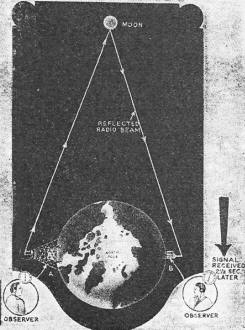
Gernsback's 1927 proposal was to erect a powerful short-wave
transmitter at some point on the globe, with the receiver at its antipodes. Note
exact time (2½ seconds) predicted in article written 19 years ago.
Interplanetary contact rests on the development of improved equipment: a superpower
transmitter, a razor-sharp antenna beam and an increased receiver sensitivity. Only
when we can deliver a signal to these planets so strong that we receive an echo
from the impact, can we know we are getting there. When we receive this echo, we
will know, ipso facto, we can exercise electronic control in the void between and
on that planet.
With continued and accelerated research at the Signal Corps Engineering Laboratories
we hope to break through to these new horizons of man's ability to talk and impose
his will in space.
No nation on earth wants another war. And it is everyone's hope, and the end
toward which we are working, that our research will benefit mankind and make this
world a better place to live in.
But if America is ever faced with a push-button war, the Signal Corps will design
the button.
Moon-Radio Predicted in 1927 (p503)
Readers of the Gernsback publications will not be too surprised to hear of radio-radar
contacts with the moon, since such communications was accurately predicted 19 years
ago in an article by Hugo Gernsback, entitled: "Can We Radio the Planets?" and published
by him in his former magazine, Radio News, February, 1927.
The article foretold exactly the results now had by the Army Signal Corps scientists.
An illustration pictured a radio transmitter on the earth wit the moon overhead
and the reflected radio beam coming back. At each side of the earth an observer
was shown monitoring the transmitter and received waves, with a clock indicating
two and a half seconds elapsed time between the outgoing and incoming signal.
Posted April 16, 2021
|















